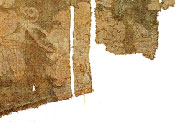 |
 |
|||||||||||||||||||||||||||||||||||||||
 |
||||||||||||||||||||||||||||||||||||||||
 |
||||||||||||||||||||||||||||||||||||||||
| CHAPTER 9 | ||||||||||||||||||||||||||||||||||||||||
 |
||||||||||||||||||||||||||||||||||||||||
| 09.01 Roundel with two dragons chasing a flaming pearl (10-11th century) |
||||||||||||||||||||||||||||||||||||||||
 |
Couching stitch with wrapped gold and silver threads on complex gauze Roundel size: H33cm; W39cm Private collection, London |
|||||||||||||||||||||||||||||||||||||||
| THE BOOK | ||||||||||||||||||||||||||||||||||||||||
| AUTHOR | ||||||||||||||||||||||||||||||||||||||||
| CONTENTS | ||||||||||||||||||||||||||||||||||||||||
| ORDER | ||||||||||||||||||||||||||||||||||||||||
| There are many fragments of this embroidery, originally belonging to the same robe. Wrapped gold and silver threads are attached to the surface of a yellow luo gauze by couching stitches. This was the most expensive technique in embroidery, applied mainly on garments for members of the imperial household. The roundel is composed of two three-clawed dragons, one ascending, and the other descending, encircling the flaming pearl in the centre. The form of the dragon is typical of the Liao dynasty, but the combination of ascending and descending dragons in a single roundel is unusual. The only other textile with such an arrangement of dragons is a kesi cover with gold threads and decorated with dragons and waves pattern found in Yemaotai, Faku, Liaoning. Textual records of the emperor's robes being decorated with dragons can be traced to early history. The earliest visual image is found in the wall painting of Dunhuang and it depicts the emperor of Xixia kingdom in a robe with dragon roundels. Among archaeological material, the robe from which this fragment is derived is the earliest dragon robe. |
||||||||||||||||||||||||||||||||||||||||
| CONTACT | ||||||||||||||||||||||||||||||||||||||||
| LINKS | ||||||||||||||||||||||||||||||||||||||||
|
|
|||||||||||||||||||||||||||||||||||||||